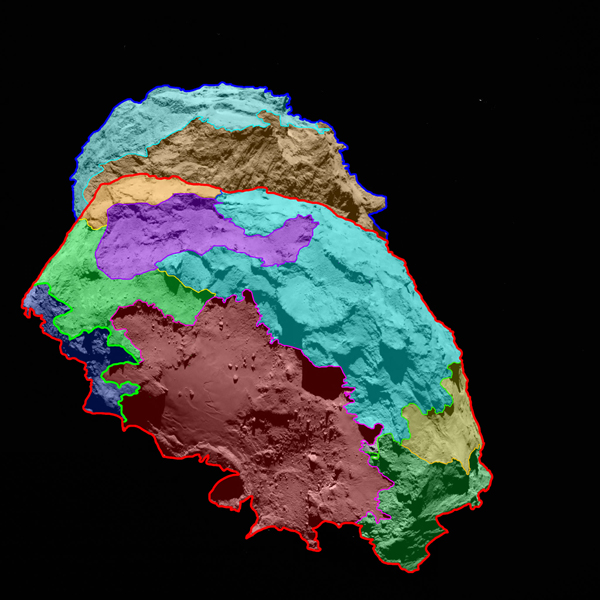From the webpage:
Scientists have found that the surface of comet 67P/Churyumov-Gerasimenko — the target of study for the European Space Agency’s Rosetta mission — can be divided into several regions, each characterized by different classes of features. High-resolution images of the comet reveal a unique, multifaceted world.
ESA’s Rosetta spacecraft arrived at its destination about a month ago and is currently accompanying the comet as it progresses on its route toward the inner solar system. Scientists have analyzed images of the comet’s surface taken by OSIRIS, Rosetta’s scientific imaging system, and defined several different regions, each of which has a distinctive physical appearance. This analysis provides the basis for a detailed scientific description of 67P’s surface. A map showing the comet’s various regions is available at: http://go.nasa.gov/1pU26L2
“Never before have we seen a cometary surface in such detail,” says OSIRIS Principal Investigator Holger Sierks from the Max Planck Institute for Solar System Science (MPS) in Germany. In some of the images, one pixel corresponds to a scale of 30 inches (75 centimeters) on the nucleus. “It is a historic moment — we have an unprecedented resolution to map a comet,” he says.
The comet has areas dominated by cliffs, depressions, craters, boulders and even parallel grooves. While some of these areas appear to be quiet, others seem to be shaped by the comet’s activity, in which grains emitted from below the surface fall back to the ground in the nearby area.

The Rosetta mission:
Rosetta launched in 2004 and will arrive at comet 67P/Churyumov-Gerasimenko on 6 August. It will be the first mission in history to rendezvous with a comet, escort it as it orbits the Sun, and deploy a lander to its surface. Rosetta is an ESA mission with contributions from its member states and NASA. Rosetta’s Philae lander is provided by a consortium led by DLR, MPS, CNES and ASI.
Not to mention being your opportunity to watch semantic diversity develop from a known starting point.
Already the comet has two names: (1 67P/Churyumov-Gerasimenko and 2) Rosetta’s comet. Can you guess which one will be used in the popular press?
Surface features will be described in different languages, which have different terms for features and the processes that formed them. Not to mention that even within natural languages there can be diversity as well.
Semantic diversity is our natural state. Normalization is an abnormal state, perhaps that is why it is so elusive on a large scale.